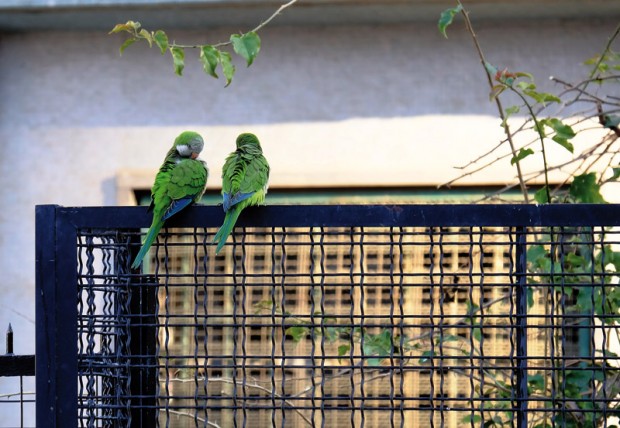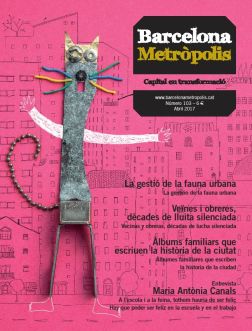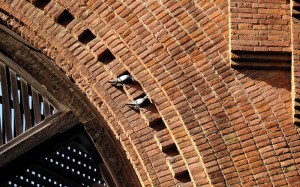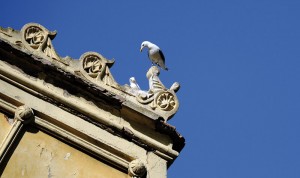An abundance of food, few predators and a more stable and temperate climate are what draws birds to colonize the urban environment so effectively. The main benefits we get from this are intangible and to do with entertainment and aesthetic appreciation.

Parakeets in Plaça de Josep Maria Folch i Torres, that today thrive in the city, but were almost completely absent just a few decades ago.
Photo: Vicente Zambrano
Seven-thirty on a Sunday morning in winter at the junction of Avinguda Diagonal and Carrer Tuset: the last clubbers are leaving the discos and bars and dragging themselves home, on the look-out for taxis, oblivious to what is around them. The street has become a rubbish tip of organic matter, strewn with dropped or discarded food and drink; a feast for the pigeons and gulls that seize their opportunity while there are no people or dogs around and before the council street-cleaners arrive wielding their hoses and pushing the rubbish to the edge of the street, where it will be swallowed up by the sweeping vehicle. The avian activity is frenetic; fifty pigeons and ten gulls scrabble to guzzle down the left-overs. In the midst of the mayhem, a careless pigeon falls prey to a gull that prefers a hot meal to cold fare. The perp is a subject that inhabits the junction of Avinguda Diagonal and Carrer Aribau and specializes in hunting pigeons on Plaça de Francesc Macià. In half an hour the street will be clean and the birds will head off elsewhere to earn a crust.
From an ecological point of view, this story helps to explain the difference between natural and artificial systems. In the city, the abundance of food, the presence of very few predators and a more stable and temperate microclimate are the key factors in understanding why birds, who are opportunistic creatures, colonize this environment so effectively.
But just how many species of birds are there in Barcelona? Most people think that there are only pigeons, gulls, sparrows and parakeets. Some would add swallows to this list, although there are actually very few of them and they are often confused with the much more common swift. The reality is very different. Barcelona’s municipal area covers 0.32% of Catalonia but accommodates 30% of the different bird species that breed in the country. Just over eighty species nest in the city and around 250 species can be spotted in winter and during migration. The average resident of Barcelona is unaware that between ten and thirty species may be found in the area around their home. The most common species, besides those already mentioned, are the woodpigeon, the collared dove, the blackbird and the starling, all easy to spot because they tend to feed off the ground. Others have to be looked for in the sky, like the common swifts and Alpine swifts that vociferously fly above us in summer. Searching among the vegetation in our parks will lead to further discoveries.
In Barcelona, green space is a relatively recent addition, and most of the city’s parks are less than twenty years old, with few old trees. Nevertheless, some of the more historic parks, such as Palau Reial, Ciutadella and Laberint d’Horta, make excellent observatories for spotting tits, Sardinian warblers, chiffchaffs and flycatchers. Their proximity to Collserola means that the Jardins de Can Sentmenat and the Parc del Castell de l’Oreneta are both home to the European green and the great spotted woodpeckers. Environmental Sciences students are starting to learn more about the wild birds found in the gardens of the Zoo. The abundant supply of straw, mud and other materials used for nest-building, the pieces of food that fall from animal troughs or the hands of visitors, the large number of water tanks and the absence of pet dogs all help to make the Zoo the best location in the city. But anywhere in the city is good for spotting, identifying, studying and enjoying birds. One need only be patient, attentive, and avoid sudden movements that may spook them.
Urban development and city life are ever-changing and the bird community responds to these changes. Several species prevailing today did not even exist in the city a few decades ago. The five thousand monk parakeets we have today descend from a few that were released into the wild in 1965. The collared dove, from Southern Asia, appeared in Barcelona in 1989. Until recently, the woodpigeon was a woodland bird reluctant to venture outside the forests of Collserola. Its presence in the city is due to the emergence of a branch of the species that is highly adapted to urban life, very prolific and unafraid of people. The yellow legged gull started to breed in 1980, on the roof of the seminary in Carrer Diputació. There are now some two hundred pairs nesting on residential roof terraces. Before the 1980s, the common starling only came to spend the winter in Barcelona. In the late sixties it was common to see vast flocks of them flying over Plaça Catalunya in the evening, trying to elude the peregrine falcon out to catch one. Nowadays only small flocks come to roost in Plaça Catalunya, but starlings have been nesting there since 1985, when they became year-round residents. Finally, the peregrine falcon has started to breed here again after a successful reintroduction scheme that reversed its disappearance, following the death of the pair that, between 1970 and 1975, had nested in the bell tower of the church of Santa Maria del Mar.
How do birds help us?
Humans exploit goods and services from nature, a concept today known as ecosystem services, which technically refers to the direct or indirect contributions made by ecosystems to human welfare. Birds also provide ecosystem services. In Barcelona, for example, they help with pest control: insectivorous birds can help to avoid the use of insecticides in the city’s green spaces. But the main service they provide takes the form of a range of intangible benefits, such as entertainment or aesthetic appreciation, which are a type of cultural service, strongly linked to their beauty and to how easy it is to observe them. The proximity between people and birds means that many city-dwellers enjoy bird-watching, connect with nature through birds or find artistic inspiration in them. Generally speaking, city dwellers like the soundscape that birds create in parks and gardens, improving our physical and mental wellbeing, while in primary and secondary schools, putting up nesting boxes or bird-watching activities bring children and adolescents closer to the nature around them.
Over fifty years ago, a lecturer at the University of Barcelona (UB) published several articles on the birds of Barcelona’s parks, a novelty back then, because city fauna was forgotten or neglected. In the seventies and eighties, Barcelona Zoo, the Museum of Zoology (today the Natural Sciences Museum of Barcelona) and the UB continued this work. In the last fifteen years, NGOs such as the Catalan Ornithology Institute (ICO) and experts from the City Council have also helped. Together they have created a network of naturalists, scientific institutions and council bodies working on urban science projects. One result of this collaborative work was the project initiated in 2012 to compile an atlas of Barcelona’s nesting birds. The project, promoted by the Council, which signed an agreement with the Barcelona Zoo Foundation, UB and ICO, was implemented by over 300 volunteers. This atlas will provide us with knowledge of the distribution of birds in the city during the breeding season and information on the services they provide to city-dwellers.
The article is finished. We leave the Faculty of Biology: a male black redstart keeps watch atop Gaudí’s arch. First-rate architecture, a plentiful community of birds and growing public interest in learning about it and enjoying it all come together in Barcelona.





